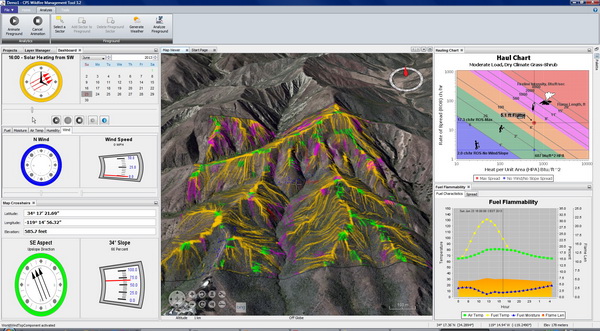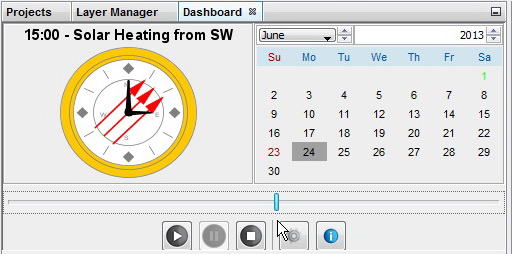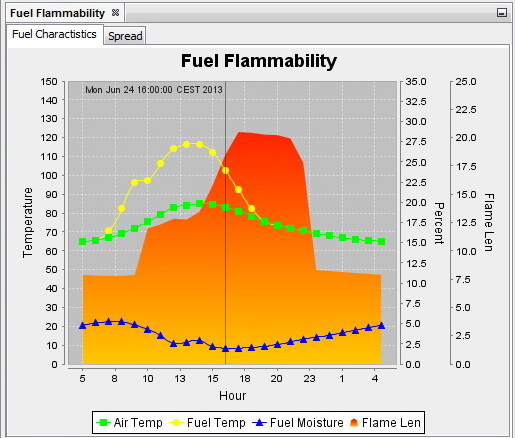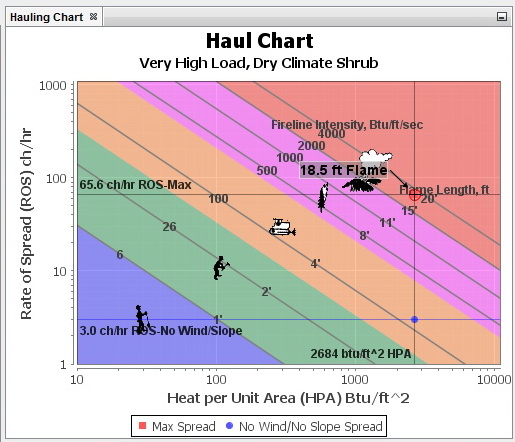Quick Start: Fire Behavior Animation
The Fire Behavior panels display various outputs from the BEHAVE fire spread equations. All of the fire behavior panels are dynamic. That is, any change in time, location, wind, fuel model, moisture, air temperature or humidity will be reflected immediately in the following panels.
Prerequisite: Analyze the Fireground
See the Fireground Analysis page.
Step 1: Animate the Fireground

1. Choose Analysis > Animate Fireground.

The fireground sector is now animated with the dynamic fire paths. The Haul Chart and Fuel Flammability graphs will show you the fire behavior for the selected hour. The hour is controlled by the slider and play/pause buttons in the Dashboard.
Step 2: Control the Animation

Use the Play/Pause buttons and the slider to control the selected
hour. Note: The Stop button only stops the clock, not the
fire path animation. Click the Analysis > Cancel Animation
button to stop the fire path animation.
Direction of Max Fire Spread
Figure 13. Fire Spread tab
This dynamic panel shows the direction of maximum spread and the flame length. Wind is often a dominating force, but note that when the wind speed is low, the terrain's aspect and slope exert a greater influence.
Experiment with various wind directions and speeds on different terrain aspects and slopes to better understand this relationship.
Fuel Flammability

Figure 14. Fuel Characteristics tab showing fuel versus air temperatures
This dynamic panel shows the computed fuel temperature and air temperature at the current location. This chart reflects the solar preheating of fuel and responds to changes in location.
A precept of the Campbell Prediction System method is that firefighters should recognize when fuel is, or will be, at its peak temperature. Experiment with changes in the terrain aspect to see when the hours of peak fuel temperature occur.
Haul Chart

Figure 15. Haul Chart
The Haul Chart is a recognizable fire behavior diagram in wildland firefighting. The Haul Chart was so named because it infers the relative intensity of the fire behavior through graphical representations of firefighters working (haul firefighters), equipment working (haul equipment), trees torching (haul retardant), and crown fire (haul everybody to safety). Since fireline intensity and flame length are directly proportional (Byram, 1959), the larger one gets the larger the other gets. And since we can visually assess the flame length, the Haul Chart is an excellent tool for measuring the safety and effectiveness of various fireline resources.
Haul Chart Interpretations
The fireline interpretations of the Haul Chart are as follows: Figure 15. Haul Chart Interpretations (from Fireline Handbook, Appendix B.)
| FLAME LENGTH (Feet) | FIRELINE INTENSITY (BTU/Ft/Sec) | INTERPRETATIONS |
|---|---|---|
| 0-4 | 0-100 | Persons using handtools can generally attack fires at the head or flanks. Handline should hold the fire. |
| 4-8 | 100-500 | Fires are too intense for direct attack on the head by persons using handtools. Handline can not be relied on to hold fire. Equipment such as dozers, engines, and retardant aircraft can be effective. |
| 8-11 | 500-1,000 | Fires may present serious control problems such as torching, crowning, and spotting. Control efforts at the head of the fire will probably be ineffective. |
| 11+ | 1000+ | Crowning, spotting, and major runs are common, control efforts at the head of the fire are ineffective. |
| ADJECTIVE RATING | FLAME LENGTH | IMPLICATION |
|---|---|---|
| LOW | 0-1 | Fire will burn and will spread however it presents very little resistance to control and direct attack with firefighters is possible |
| MODERATE | 1-3 | Fire spreads rapidly presenting moderate resistance to control but can be countered with direct attack by firefighters |
| ACTIVE | 3-7 | Fire spreads very rapidly presenting substantial resistance to control. Direct attack with firefighters must be supplemented with equipment and/or air support. |
| VERY ACTIVE | 7-15 | Fire spreads very rapidly presenting extreme resistance to control. Indirect attack may be effective. Safety of firefighters in the area becomes a concern. |
| EXTREME | >15 | Fire spreads very rapidly presenting extreme resistance to control. Any form of attack will probably not be effective. Safety of firefighters in the area is of critical concern. |



